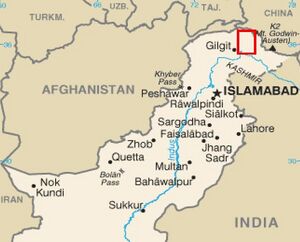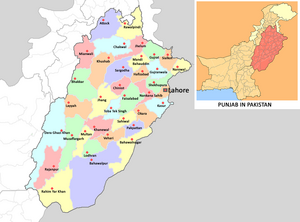Rawalpindi



Rawalpindi (Hindi:रावलपिंडी, (Urdu, Punjabi: راولپنڈی) is a city and district in Punjab province of Pakistan. Its ancient name was Shahdheri.
Tahsils in the District
Jat clans in Rawalpindi District
According to 1911 census, the following were the principal Muslim Jat clans in in Rawalpindi District:
Aura (610), Bangial (1,204), Baghial (96), Bains (1,332), Boria (46), Chhina (692), Dhamial (1,502), Dhamtal (520) , Gondal (816), Hindan (541), Kalial (129), Kanial (149), Khatrils (2,004), Mogial (69), Mial (25), Sudhan (175), Sial (420) and, Thathaal (53).
Main tribes
The main tribes of the district are the Rajpoot, Syed, Gakhars (AKA Kiani,Rajas), Janjuas, Awans, Gujjars, Jats, Kassar, Sheikh (Caste), Abbasi, Bhatti, Chauhan, Mughals, Qureshi (Caste), Rawal, and Satti.
History

In ancient times the whole or the greater part of the area between the Indus and the Jhelum seems to have belonged to a Naga tribe called Takshakas, who gave their name to the city of Takshasila. Known as Taxila by the Greek historians, the location of the ancient city has been identified to be in the ruins of Shahdheri in the north-west corner of the District. At the time of Alexander's invasion Taxila was described by Arrian as a flourishing city, the greatest indeed between the Indus and the Hydaspes; Strabo adds that the neighbouring country was crowded with inhabitants and very fertile; and Pliny speaks of it as a famous city situated in a district called Amanda.
The invasion of Demetrius in 195 B.C. brought the Punjab under the Graeco-Bactrian kings. Later they were superseded by the Sakas, who ruled at Taxila with the title of Satrap. At the time of Hiuen Tsiang the country was a dependency of Kashmir.[1]
Rawalpindi has been inhabited for thousands of years, it is believed that a distinct culture flourished on this plateau as far in c.1000 BC. The material remains found at the site prove the existence of a Buddhist establishment contemporary to Taxila and of a Vedic civilization. The nearby town of Taxila has another significance; according to the Guinness Book of World Records it has the world's oldest university - Takshashila University. Rawalpindi is also known by nick-name Garh Gajni,
Sir Alexander Cunningham identified certain ruins on the site of the cantonment with the ancient city of Ganjipur or Gajnipur, the capital of the Bhatti tribe in the ages preceding the Christian era. Graeco-Bactrian coins, together with ancient bricks, occur over an area of 500 ha (2 mi²). Known within historical times as Fatehpur Baori, Rawalpindi fell into decay during one of the Mongol invasions in the fourteenth century.[2]
It appears that the ancient city went into oblivion as a result of the White Hun devastation. The first Muslim invader, Mahmud of Ghazni (979-1030), gave the ruined city to a Gakhar Chief, Kai Gohar. The town, however, being on an invasion route, could not prosper and remained deserted until Jhanda Khan, another Gakhar Chief, restored it and named it Rawalpindi after the village Rawal in 1493. Rawalpindi remained under the rule of the Gakkhars until Muqarrab Khan, the last Gakkhar ruler, was defeated by the Sikhs under Sardar Milka Singh in 1765. Singh invited traders from the neighbouring commercial centres of Jhelum and Shahpur to settle in the territory.[3]
Early in the nineteenth century Rawalpindi became for a time the refuge of Shah Shuja, the exiled king of Afghanistan, and of his brother Shah Zaman. The present native infantry lines mark the site of a battle fought by the Gakhars under their famous chief Sultan Mukarrab Khan in the middle of the eighteenth century. Rawalpindi was taken by Sikh ruler Maharaja Ranjit Singh in 1818.
Till 1965, Karachi was the capital of Pakistan. During Indo-Pak was of 1965, Karachi's port was heavily damaged by Indian navy. Resultantly, the capital was shifted to Rawalpindi after the war. After some years when new capital Islamabad was built, the capital was shifted there.
Notable persons
External links
References
- ↑ Rawalpindi District - Imperial Gazetteer of India, v. 21, p. 264.
- ↑ Rawalpindi Town - Imperial Gazetteer of India, v. 21, p. 272.
- ↑ Rawalpindi Town - Imperial Gazetteer of India, v. 21, p. 272.
Back to Pakistan

